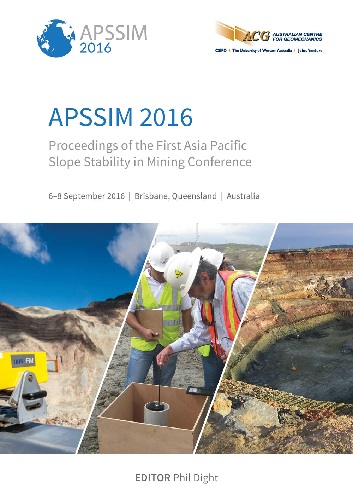New results of large-scale testing of high-tensile steel meshes and soil nails for slope stabilisation and validation of modelling software

|
Authors: Bucher, R; Wendeler, C; Baraniak, P |
DOI https://doi.org/10.36487/ACG_rep/1604_49_Bucher
Cite As:
Bucher, R, Wendeler, C & Baraniak, P 2016, 'New results of large-scale testing of high-tensile steel meshes and soil nails for slope stabilisation and validation of modelling software ', in PM Dight (ed.), APSSIM 2016: Proceedings of the First Asia Pacific Slope Stability in Mining Conference, Australian Centre for Geomechanics, Perth, pp. 709-720, https://doi.org/10.36487/ACG_rep/1604_49_Bucher
Abstract:
The stability of newly cut or natural slopes is an important issue of geotechnical engineering. Regardless of the scale of the project, the design and the execution have to assure maintenance-free and, more importantly, safe utilisation of the slope. Nowadays, a geotechnical engineer can choose from a number of different, available slope stabilisation methods. Nevertheless, one of the most frequently chosen methods is soil nailing in combination with flexible facing. In this configuration, the soil nailing is designed to stabilise deep-seated instabilities, while localised instabilities have to be stabilised by the flexible facing, typically represented by high-tensile steel wire mesh. In order to assure proper slope stabilisation, the soil nails and the flexible facing have to act as one integrated system. Such a system has been tested lately in large scale within this R&D project supported by the Swiss Commission for Technology and Innovation (CTI). The large scale setup, widely described in Cała et al. (2013), consisted of an inclinable large box (12 × 10 × 1.2 m), soil material, soil nails, high-tensile steel wire mesh, steel plates (linking nail heads and mesh), connection clips (linking two sheets of mesh), and boundary ropes. The entire setup was lifted up on one side to imitate the inclination of the slope. While lifting the box up, several measurements were taken, e.g. tension forces and bending moments in the nails or deformation of the mesh. In total, 31 large-scale tests were conducted, at first to check the testing setup and later to test the interactions of the nails and high-tensile steel mesh, which were put together in different arrangement and configurations. The most important testing variables were soil material, nail pattern, type of steel wire mesh and connection plate. The main aim of this paper is to present the analysis of the performance of three meshes composed of 2, 3 and 4 mm diameter wire, tested in comparable conditions (the same soil conditions, nail pattern and connection plate). The purpose of this analysis was to show the distinction in bearing capacity and range of deformation of meshes produced from the same steel but of different wire diameter. This analysis was also used for the purpose of validation of already existing dimensioning concept based on small scaled laboratory tests.
Keywords: large-scale field test, soil nails, flexible facing, high-tensile steel mesh
References:
Baraniak, P & Schwarz-Platzer, K, Stolz, M, Shevlin, T & Roduner, A 2014, ‘Large scale field tests for slope stabilizations made with flexible facings’, GEOHAZARDS 6, Kingston.
Cała, M, Flum, D, Roduner, A, Rüegger, R & Wartmann, S 2012, TECCO Slope Stabilization System and RUVOLUM® Dimensioning Method, Bad Langesalza, Beltz Bad Langesalza GmbH,
media/TECCO%20the%20book%20pre-announcement_en_screen.pdf
Cała, M, Stolz, M, Baraniak, P, Rist, A & Roduner, A 2013, ‘Large scale field tests for slope stabilizations made with flexible facings’, in Proceedings of EUROCK 2013, Rotterdam, Balkema.
Geobrugg, AG 2011, ‘TECCO Slope Stabilization System’, Summary of Published Technical Papers 1998–2011.
Geobrugg, AG 2015, Geobrugg TECCO®, brochure.
Rüegger, R, Flum, D & Haller, B 2000, Hochfeste Geflechte aus Stahldraht für die Oberflächensicherung in Kombination mit Vernagelungen und Verankerungen, 2nd Building in Soil and Cliffs Colloquium at the Technical Academy of Esslingen, Germany.
© Copyright 2026, Australian Centre for Geomechanics (ACG), The University of Western Australia. All rights reserved.
View copyright/legal information
Please direct any queries or error reports to repository-acg@uwa.edu.au
View copyright/legal information
Please direct any queries or error reports to repository-acg@uwa.edu.au